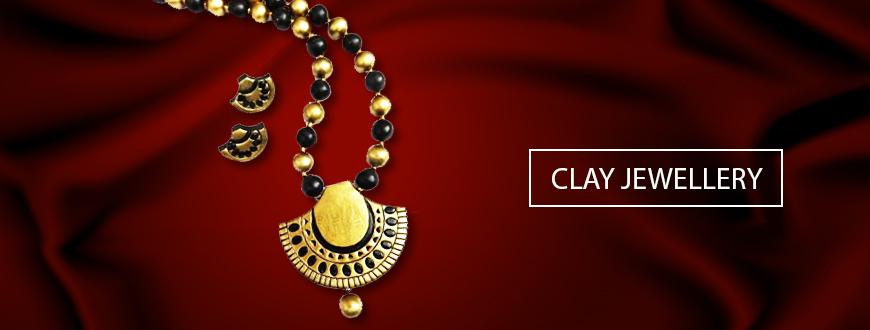Kalyan Wiki

Clay Jewellery
Clay is a mineral, which is formed due to the chemical weathering or the hypothermal reaction of rocks. It has been used over the years by craftsmen for making pottery, for utility and decorative purposes. In our time, clay is used for some other purposes also. For instance, along with pottery making, it is also used to make jewellery these days. Mainly there are three types of clay jewellery; polymer clay jewellery, terracotta jewellery, and metal clay jewellery.
Polymer Clay Jewellery: This jewellery is made up of polymer clay that is a modelling clay, which can be hardened. Polymer clay is derived from the chemical 'Polymer Polyvinyl Chloride' and contains no natural clay minerals. It is called clay because of its clay-like properties. The jewellery making process includes various steps, such as the mixing of the clay, making beads or the desired jewellery, baking the created jewellery, and sorting out according to the design. Since it's already pigmented artists won't have to colour the item again. The jewellery can be decorated using different kinds of stones and pearls according to the design.
Terracotta Jewellery: Unlike Polymer Jewelry, Terracotta Jewelry is made of natural clay, which gives it a reddish-brown colour. Terracotta means "Baked Earth", which indicates how it is made. Since it's baked, Terracotta jewellery is very sturdy and waterproof. The process of jewellery making is labour-intensive; -from the modelling of the clay to the baking of the modelled clay requires a lot of steps. The terracotta jewellery is baked in an oven, and since it's made of natural clay, it needs to be either coloured or glazed. Terracotta jewellery has been and still is a favourite choice among women.
Metal Clay Jewellery: 'Metal Clay' or 'Precious Metal Jewelry (PMC)' is the kind of jewellery made of a medium with various precious metals like gold, silver, or copper mixed with an organic binder and water. Unlike both the above mentioned types of clay jewellery, it's a bit hard to make this kind of jewellery. Modelling of the clay is simple, just like any clay, and after the drying process is over it is fired either in a kiln, with a gas torch, or on a gas stove. When it is fired, the organic binder in the clay burns away, and the pure metal, in its design, is left behind.
Clay jewellery requires careful handling. And also, since it is non-reactive, it doesn't cause any allergies.







